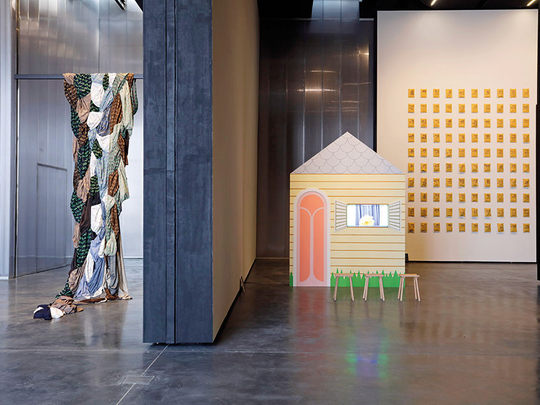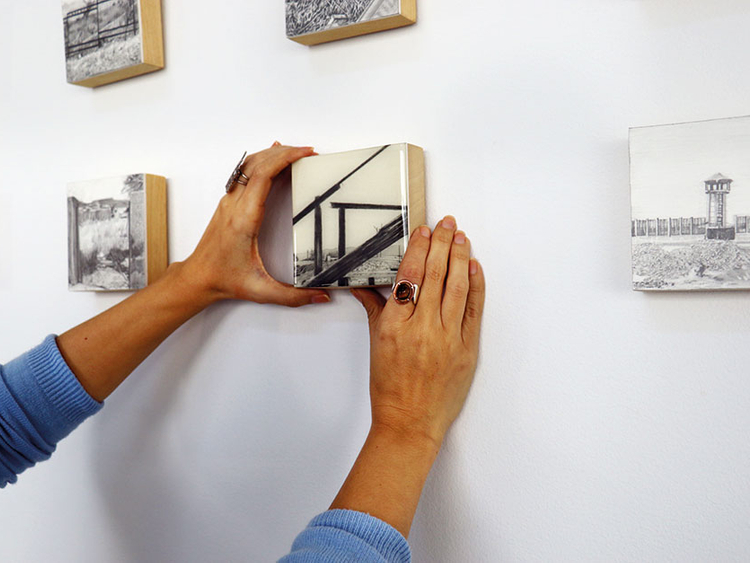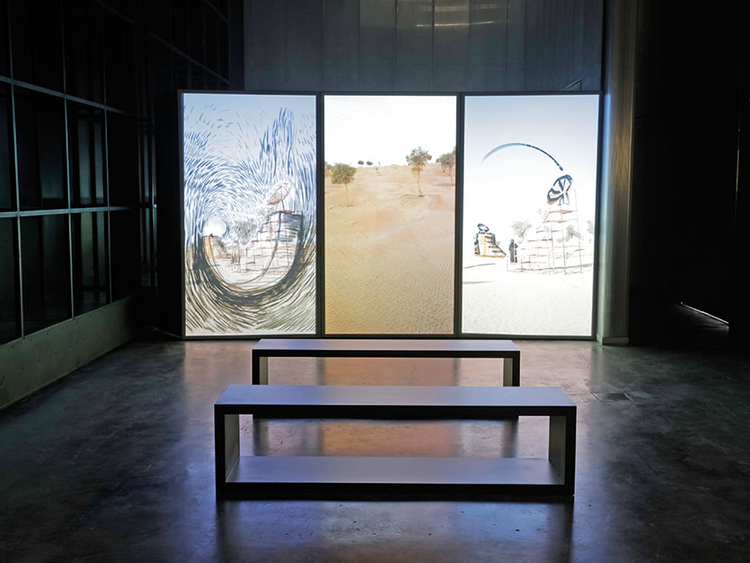
UAE Unlimited is presenting new commissioned works by 10 emerging UAE-based artists in the 2018 edition of its annual art exhibition titled, Ishara: Signs, Symbols and Shared Languages.
The show has been organised in collaboration with Alserkal Programming and supported by the Ministry of Culture and Knowledge Development. It will run at Concrete in Alserkal Avenue until April 1.
His Highness Shaikh Zayed Bin Sultan Bin Khalifa Al Nahyan, founder of UAE Unlimited says, “As our exhibitions have developed over the years, so too, have the size and scale of the artworks. With this year’s edition, our commissioned artists were given the opportunity to produce artworks that would be on display in this spectacular space, Concrete, to experiment with proportions found only in leading global museums.”
The show’s title, Ishara is the Arabic word for ‘sign’ and refers to a theme that is based on a broad understanding of the meaning and use of language, which includes communication through gestures, indications, linguistic marks and commonly used signals that transcend language.
The show is curated by Karim Sultan, director of the UAE-based Barjeel Art Foundation, with Laura Metzler, curator at the Maraya Art Centre in Sharjah as senior curatorial adviser on the project.
“The theme of this show is relevant to the UAE because its major cities are port cities where the presence of traders and travellers arriving from various countries requires the inhabitants to constantly navigate multiple languages and systems of communication. This often leads to the development of a lingua franca or common cross cultural language constructed from elements of various languages. Our curatorial process began with the idea of a lingua franca but gradually developed into a broader exploration of signs, body language, coded symbols, self-constructed systems and natural or technology driven networks that can facilitate communication or create barriers between people,” Sultan says.
The artists selected for the exhibition reflect the multi-cultural community of the UAE. They include Chndy (Mohammad Al Kindi), who is from Oman, Iraqi-Canadian artist Cheb Moha, Kuwait-born Palestinian Dina Khorchid, American artist and art educator Flounder Lee, Saba Qizilbash from Pakistan, and Emirati artists Amna Al Dabbagh, Farah Al Qasimi, Nasir Nasrallah, Salem Al Mansoori and Shaikha Al Ketbi. Each artist has addressed the theme in a different way through artworks that range from videos, interactive installations, prints and drawings to 3D printed sculptures and digital works on social media.
Al Dabbagh’s textile-based installation, The Hanging Odes, goes back to the roots of the Arabic language. It is inspired by Al Mu’allaqat, a group of 10 long poems by famous poets that are considered the best poems of the pre-Islamic era and according to legend were written in gold on Coptic linen and hung on the curtains covering the Kaaba.
The artist has embroidered these poems on woolen fabrics of different colours and artfully intertwined them to create a hanging installation that symbolically sets up a dialogue between the poets. With parts of the poems concealed in the folds, the work takes the form of concrete poetry, visually representing the beauty of the poems. The artist thus acknowledges the unsurpassed beauty and history of the ancient poems while subverting their strict structure and metrical system to create a contemporary interpretation.
Khorchid’s installation, Through a Trail, is inspired by her Palestinian heritage and looks at language as a carrier of histories and memories. The artist has handprinted motifs from traditional Palestinian embroidery on linen scrolls that have been arranged in layers to represent a landscape. The motifs, which include olive and grape branches, birds and the sun constitute a visual language that relates to Palestinian identity and connects the people to a land they long for but have no access to.
Salem Al Mansoori’s sculptures are also embedded with a coded language. The artist wrote a computer programme that analyses sound data, extracts parameters such as pitch, tempo and intonation of sound files and feeds them into an algorithm that generates 3D shapes.
Using this programme he has transformed recordings of three seminal texts that explore the relationship between art and language into beautiful 3D sculptures. The texts include, Going Inside by Hassan Sharif; Body Language by Hassan Madan; and Abbas Kiarostami’s poem In the Dictionary. Al Mansoori’s mystical sculptures thus represent the essence of the texts, offering a concrete manifestation for contemplating the great ideas expressed in them.
The artist was also commissioned to create a special work to commemorate the Year of Zayed. Using the same process, he has transformed a recording of an inspiring speech by the founding father of the UAE into a beautiful sculpture, which is presented in the exhibition along with the recording.
Nasrallah’s project, Forgotten Title, looks at communication systems and languages that were once part of daily life but are being lost or confined to museums waiting to be deciphered. He has sealed 100 everyday objects in 100 brown envelopes and written a description of the object and its significance in his daily life on each envelope, but in a coded language comprising simple marks. While viewers cannot read this, over time the artist himself will forget the code and be unable to read what he has written, turning the envelopes that were meant to facilitate communication into a barrier that obstructs it.
Qizilbash’s installation, Land Marks, also features 100 individual artworks. These are haunting graphite drawings depicting desolate borders, gates and unmanned checkpoints at unidentified locations. The work focuses on shared language barriers rather than openings by evoking the eerie silence, hostile fencing and surveillance at lines of control and conveying the unease of the intimidating checks, bureaucratic holdups and forced deportations associated with international borders.
Al Qasimi has also explored a transitional zone between two languages where meaning becomes fragile. Her video, Everybody Was Invited to A Party, is inspired by an Arabic version of Sesame Street from the 1980s. Her handmade puppets represent human emotions and present language and letters as malleable objects with variable meanings. Using bilingual stationery and translation textbooks, the video moves back and forth between English and Arabic humourously highlighting the mishaps of translation.
Lee has taken a scientific approach to the theme of communication. His large-scale installation, Mycelial Meshing, is a mesh constructed from steel pipes, concrete, electrical cables, lighting, sensors and an infrasound system. The work is interactive and reacts to approaching visitors by activating subtle light and sound signals across the entire network.
The work is inspired by networks formed by fungi such as mycorrhiza, whose mycelia reach out and connect to the roots of various plants forming a network across which food, water and information about predators is shared. It thus represents a lingua franca for inter-species communication.
The work also refers to the many interconnected networks of infrastructure and communication that human beings are part of, from family and friends to the internet and the electrical grid, where the ripple effect of one action changes entire ecosystems. The artist has used water pipes to highlight the need to conserve water and show how its scarcity in one area can impact the entire system. The sci-fi look, intimidating size and interactive nature of the work alludes to artificial intelligence and the emergence of post human languages.
Al Ketbi’s understanding of language is a metaphysical, wordless, spiritual and inward one. She is interested in communicating with her own multiple levels of consciousness and subconsciousness. Her three-channel video, titled Ath’thaniyah, features enigmatic architectural structures such as a set of haphazard stairs leading up to a platform with a satellite dish and a performance. These are all intuitive reconstructions of her dreams and thoughts through which the artist attempts to communicate and connect more deeply with herself.
Unlike Al Ketbi’s physical manifestations of her inner world, Chndy and Cheb Moha have created works that exist in the virtual world as digital projects on Instagram accounts, which can be accessed on screens and ipads in the exhibition and on smart devices.
Chndy’s work is inspired by the Arabic version of the opening credits of the Japanese anime show Digimon, which was dubbed and rewritten in Arabic in the early 2000s. The artist wants to highlight the fact that the song sung by Rasha Rizq almost two decades ago is amazingly relevant even today because it speaks about being trapped in a digital world and the dangers of our growing dependence on the technologies we have created. Chndy has created a video using sound and imagery found on the internet, where he is seen enacting the song dressed in a superhero costume also bought on the internet. The artist is inviting viewers to engage with the work through his posts on Instagram (@digitalbo0oy) throughout the duration of the show.
Moha is exploring how language evolves on social media by putting the well-known Arabic phrase Momken net’araf (Can we get to know each other) as an open-ended question in a social media account (@net3araf ). The artist will compile people’s responses and experiences with the phrase throughout the month to explore how its meaning, which can be heavy with innuendo or intention when spoken, can change when translated through social media over time while also examining whether it is possible to really get to know anybody on social media.
Every year UAE Unlimited invites established UAE-based artists as guest artists to guide the young emerging artists in the show, thus fostering a culture of mentorship within the local art community. This year Dubai-based artists Ramin Haerizadeh, Rokni Haerizadeh and Hesam Rahmanian mentored the participants by sharing their knowledge and experiences and hosting discussions and reading sessions at their home cum studio.
“Having them as mentors was extremely beneficial to the whole group because they generously shared with us their experience of exhibiting their own work across the world and their vast knowledge of art and related subjects. We met every week at their home and it was very inspiring to be surrounded by their playful artworks and eclectic and incredible collection of art and books. Not only did they select interesting and relevant books and topics for us to read and discuss, but they also went the extra mile by curating the setting for every session by arranging objects that resonated with the topics being discussed within the space. They also offered valuable feedback and personalised advice to each artist, which has transformed their work and helped them to grow,” Sultan says.
The three guest artists are presenting an installation at the show, titled Visual Poetry, which recreates the ambience of their studio space, complete with their artistic furniture, and a selection of the books, research materials, artworks and objects which influenced the artists and played an important role in the development of the exhibition.
For the young artists the show was a great learning experience and has provided them with a good platform to showcase their talent and develop their practice.
Qizilbash says, “There were many layers to this project, apart from the actual making of the works. We have learned so much at every phase from Sultan, our mentors and Aleksei, Concrete exhibitions manager. Interacting with the three mentors in their studio was both a visual and intellectually stimulating experience. I would soak in their generosity of time and wisdom while secretly eyeing the artworks all around us. As we began to develop a better understanding of each other’s practices, I was encouraged to bring in works from other ongoing projects for deeper individual discussions and to learn about other facets such as how they organised themselves, and how they dealt with galleries. It has been a fascinating journey with UAE Unlimited and I am happy that my work and ideas will be preserved and promoted beyond the show’s duration.”
Lee, who is an associate professor of studio art at the American University in Dubai says, “UAE Unlimited is a great organisation to work with and I am happy to join the impressive, growing roster of artists who have been included. It was also amazing to meet with the mentors who have such a strong practice and are so open and generous as well. Being in the show has already created a lot of interest in my work,” he says.
The exhibition has been designed by Waqas Farid. For the first time UAE Unlimited has also commissioned essays around the show’s theme for the catalogue, which were written by young UAE-based writers Saira Ansari and Taibah Albisher. The show is accompanied by a public programme of workshops, tours and panel discussions to be held at Concrete throughout the month.
“Concrete is a space re-imagined for showcasing world-class talent, and we are proud that it is part of UAE Unlimited’s journey through the Emirates. Art and culture have an immeasurable impact on our sense of identity and purpose and joining hands to further the cause of arts and culture helps us widen our reach,” Abdelmonem Bin Eisa Alserkal, founder of Alserkal Avenue says.
Jyoti Kalsi is an arts-enthusiast based in Dubai. Ishara: Signs, Symbols and Shared Languages will run at Concrete, Alserkal Avenue until April 1.














